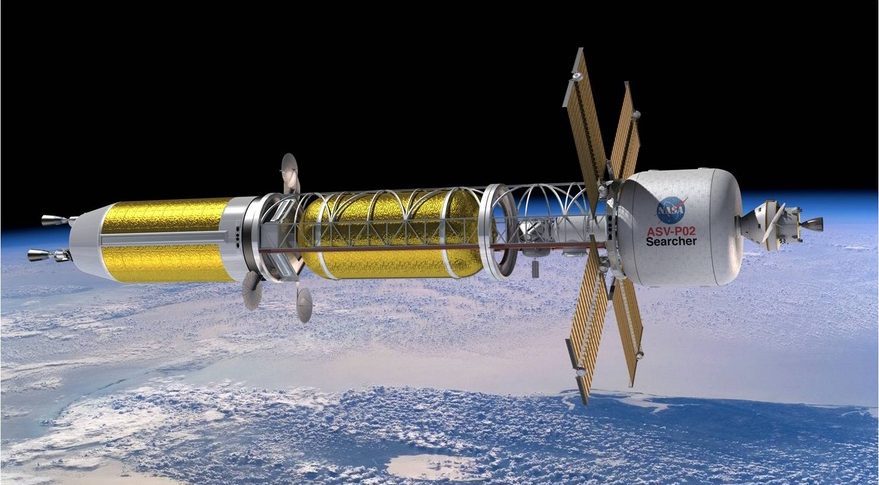Momentum Grows for Nuclear Thermal Space Propulsion

PASADENA, Calif. — With congressional funding and industry support, nuclear thermal propulsion technology is making progress for potential use on future NASA deep space missions, although how it fits into the agency's exploration architectures remains uncertain.
The House Appropriations Committee approved May 22 a commerce, justice and science (CJS) appropriations bill that offers $22.3 billion for NASA. That funding includes $125 million for nuclear thermal propulsion development within the agency's space technology program, compared to an administration request for no funding.
"The bill's investment in nuclear thermal propulsion is critical as NASA works towards the design of a flight demonstration by 2024," said Rep. Robert Aderholt (R-Ala.), ranking member of the CJS appropriations subcommittee, during that subcommittee's markup of the bill May 17. He offered similar comments in support of that project at the full committee markup.
Related: Superfast Spacecraft Propulsion Concepts (Images)
The $125 million comes on top of $100 million that Congress provided in 2019, of which $70 million was earmarked for a flight demonstration by 2024. The report accompanying the House bill makes no mention of a 2024 date for a flight demonstration, but does call on NASA to develop "a multi-year plan that enables a nuclear thermal propulsion demonstration, including the timeline associated with the space demonstration, and a description of future missions and propulsion and power systems enabled by this capability."
Nuclear thermal propulsion, where a fission reactor heats propellants like hydrogen that are then accelerated through a nozzle, holds the potential of reducing travel times for deep space missions, such as to Mars. While studied early in the Space Age, NASA programs in nuclear thermal propulsion were cancelled by the early 1970s and are only now being revisited.
The concept has support in Congress as well as the White House. "As we continue to push farther into our solar system, we'll need innovative new propulsion systems to get us there, including nuclear power," Vice President Mike Pence said in a March 26 speech at a National Space Council meeting in Huntsville, Alabama.
Get the Space.com Newsletter
Breaking space news, the latest updates on rocket launches, skywatching events and more!
That renewed work in nuclear thermal propulsion is being led by the NASA Marshall Space Flight Center in Huntsville, which Pence alluded to in his remarks. "And the president and I know there's no place on Earth better equipped to lead the world in pioneering these new propulsion technologies than Rocket City, U.S.A."
Some outside NASA also say development of nuclear thermal propulsion is important. "Nuclear propulsion is key to exploiting our capabilities beyond low Earth orbit," said Jeff Thornburg, chief executive and president of propulsion company Interstellar Technologies and a former propulsion executive with SpaceX and Stratolaunch.
Speaking on a panel at the Space Tech Expo here May 22, he supported additional work on that technology. "There's some key technology development that really needs to happen beyond the current state of the art," he said. That technology, coupled with electric propulsion, "are the future of how we're going to facilitate that expansion."
He acknowledged that, beyond the technological issues, there are regulatory ones involving such systems, whether operated by government agencies or in the private sector. He added, though, he was encouraged by comments at that March meeting of the National Space Council, where new Office of Science and Technology Policy Director Kelvin Droegemeier said his office would be reviewing nuclear space launch policy.
It's unclear, though, how nuclear thermal propulsion fits into NASA's long-term exploration plans. NASA's exploration roadmaps, as well as many developed by companies and organizations, have relied on more conventional propulsion technologies, including chemical and solar electric propulsion. Those systems don't offer the shorter travel times of nuclear thermal propulsion, but also avoid its technical and regulatory hurdles.
At a May 21 meeting of the NASA Advisory Council's science committee, agency officials showed a manifest of missions projected through 2028 to carry out its planned human and robotic exploration of the moon and development of a Gateway in lunar orbit. None of the missions listed specified the use of nuclear thermal propulsion.
- Read SpaceNews for the Latest Space Industry News
- How Vintage Rocket Tech Could Be NASA's Ticket to Mars and Beyond
- See the Next Generation of Nuclear Power for Mars Missions (Video)
This story was provided by SpaceNews, dedicated to covering all aspects of the space industry.
Join our Space Forums to keep talking space on the latest missions, night sky and more! And if you have a news tip, correction or comment, let us know at: community@space.com.

Jeff Foust is a Senior Staff Writer at SpaceNews, a space industry news magazine and website, where he writes about space policy, commercial spaceflight and other aerospace industry topics. Jeff has a Ph.D. in planetary sciences from the Massachusetts Institute of Technology and earned a bachelor's degree in geophysics and planetary science from the California Institute of Technology. You can see Jeff's latest projects by following him on Twitter.










